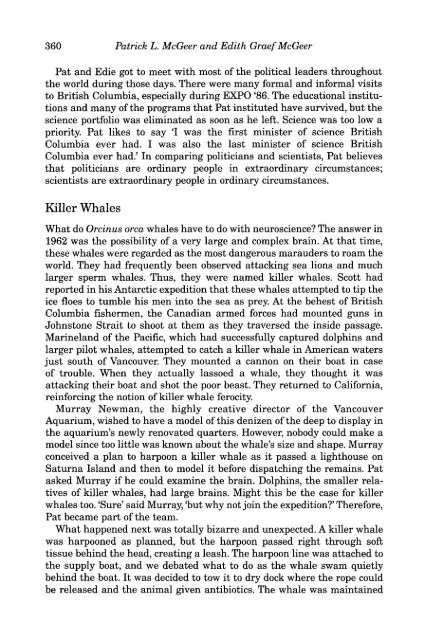Edith Graef McGeer - Society for Neuroscience
Edith Graef McGeer - Society for Neuroscience
Edith Graef McGeer - Society for Neuroscience
Create successful ePaper yourself
Turn your PDF publications into a flip-book with our unique Google optimized e-Paper software.
360 Patrick L. <strong>McGeer</strong> and <strong>Edith</strong> <strong>Graef</strong><strong>McGeer</strong><br />
Pat and Edie got to meet with most of the poHtical leaders throughout<br />
the world during those days. There were many <strong>for</strong>mal and in<strong>for</strong>mal visits<br />
to British Columbia, especially during EXPO *86. The educational institutions<br />
and many of the programs that Pat instituted have survived, but the<br />
science portfolio was eliminated as soon as he left. Science was too low a<br />
priority. Pat likes to say T was the first minister of science British<br />
Columbia ever had. I was also the last minister of science British<br />
Columbia ever had.' In comparing politicians and scientists, Pat believes<br />
that politicians are ordinary people in extraordinary circumstances;<br />
scientists are extraordinary people in ordinary circumstances.<br />
Killer Whales<br />
What do Orcinus orca whales have to do with neuroscience? The answer in<br />
1962 was the possibility of a very large and complex brain. At that time,<br />
these whales were regarded as the most dangerous marauders to roam the<br />
world. They had frequently been observed attacking sea lions and much<br />
larger sperm whales. Thus, they were named killer whales. Scott had<br />
reported in his Antarctic expedition that these whales attempted to tip the<br />
ice floes to tumble his men into the sea as prey. At the behest of British<br />
Columbia fishermen, the Canadian armed <strong>for</strong>ces had mounted guns in<br />
Johnstone Strait to shoot at them as they traversed the inside passage.<br />
Marineland of the Pacific, which had successfully captured dolphins and<br />
larger pilot whales, attempted to catch a killer whale in American waters<br />
just south of Vancouver. They mounted a cannon on their boat in case<br />
of trouble. When they actually lassoed a whale, they thought it was<br />
attacking their boat and shot the poor beast. They returned to Cali<strong>for</strong>nia,<br />
rein<strong>for</strong>cing the notion of killer whale ferocity.<br />
Murray Newman, the highly creative director of the Vancouver<br />
Aquarium, wished to have a model of this denizen of the deep to display in<br />
the aquarium's newly renovated quarters. However, nobody could make a<br />
model since too little was known about the whale's size and shape. Murray<br />
conceived a plan to harpoon a killer whale as it passed a lighthouse on<br />
Saturna Island and then to model it be<strong>for</strong>e dispatching the remains. Pat<br />
asked Murray if he could examine the brain. Dolphins, the smaller relatives<br />
of killer whales, had large brains. Might this be the case <strong>for</strong> killer<br />
whales too. 'Sure' said Murray, 'but why not join the expedition?' There<strong>for</strong>e,<br />
Pat became part of the team.<br />
What happened next was totally bizarre and unexpected. A killer whale<br />
was harpooned as planned, but the harpoon passed right through soft<br />
tissue behind the head, creating a leash. The harpoon line was attached to<br />
the supply boat, and we debated what to do as the whale swam quietly<br />
behind the boat. It was decided to tow it to dry dock where the rope could<br />
be released and the animal given antibiotics. The whale was maintained











![[Authors]. [Abstract Title]. - Society for Neuroscience](https://img.yumpu.com/8550710/1/190x245/authors-abstract-title-society-for-neuroscience.jpg?quality=85)





